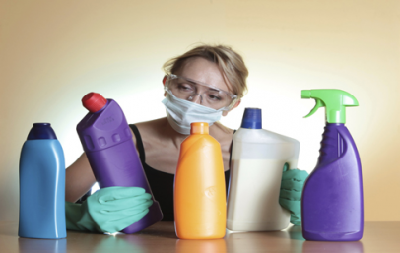
It is sobering to consider that there are some 85,000 chemicals in circulation today. It is even more alarming to realize that less than 20 percent of chemicals commonly found in products used in homes every day have never been assessed for safety.
Introduced more than three decades ago, America’s Toxic Substances Control Act has had the somewhat unbelievable stance of treating household chemicals as innocent until proven guilty. The proof is now undeniable, and we no longer have to ask whether many of these widespread chemicals in our homes are toxic to human health—but rather to what extent and in what quantities.
We now know many common household chemicals are linked to cancer, infertility, learning disabilities, and other serious diseases. Compounds we have known for decades are harmful (e.g., lead, formaldehyde, mercury, and asbestos) are still permissible in household products—even in baby goods.
Household cleaners can and frequently do contain toxic, poisonous chemicals like benzene, methanol, xylene, hydrochloric acid, and toluene. They may be dangerous to the skin, eyes, and respiratory system, and many are known carcinogens. Exposure to these chemicals in the home is especially harmful to the vulnerable developing brains and immune systems of young children.
Recently there has been a rash of antibacterial cleaners and goods on the market, from soaps to dishwashing detergents. There are literally hundreds of these cleaning products, amounting to a $1 billion a year industry. Even the surfaces of things as diverse as chopping boards, fabrics, refrigerators, plastic lunchboxes, and mattresses are increasingly being impregnated with antibacterial and other toxic substances. Advertisers would have us believe every surface and body part needs to be sanitized and chemicalized to keep us safe and healthy. Ironically, it now seems we need to be protected from the chemicals more than the germs. The main ingredient in these products is the antibiotic triclosan, or less commonly, its chemical cousin triclocarban. A form of dioxin, triclosan can weaken both the immune and nervous systems, decrease fertility, and disrupt hormones.
Washing your hands with good old soap and water kills 99.4 percent of germs, whereas washing them with an antibacterial soap kills 99.6 percent. It hardly seems worth the effort and cost, but the story does not end there. The germs that do survive are the stronger ones, and they become naturally selected and therefore ultimately resistant. Our germ phobia also results in triclosan ending up in fairly high concentrations in the water supply, where it has been identified as an endocrine disrupter in fish. If those happen to be edible fish, triclosan becomes one more of the various environmental sources of the female hormone estrogen that we are exposed to daily.
Skin is inhabited by a whole host of microbial species, most of them beneficial or benign, living in harmony with each other and their human hosts. The goal of hand-washing should not be to kill them but rather to get rid of any additional germs that don’t belong on the skin.
It's Time for Household Cleaners to Come Clean
You would think avoiding dangerous chemicals in the home would be as simple as reading the list of ingredients on products and choosing based on that. At present, however, there are no legal requirements for companies to disclose ingredients, safe or otherwise.
The Safe Chemicals Act is set to change all this. There is a groundswell of support for this bill from ordinary consumers to high-profile scientists, environmentalists, and researchers. If passed, it will require manufacturers to divulge ingredients on packaging and give the EPA the wherewithal to test, limit, and regulate dangerous substances in household cleaners.
There are safer alternatives to all of these potentially hazardous chemical concoctions. Well-established environmentally friendly brands who make household cleaning products include Seventh Generation, Shaklee, Bio-Kleen and others that are available in many stores. Home-made safe substitutes for commercial cleaners include ordinary vinegar for cleaning toilets and kitchen surfaces and bicarbonate of soda for cleaning and deodorizing ovens and fridges and removing stains. Not only are these household cleaning alternatives cheaper, simpler, and kinder to the environment and our bodies, but they work amazingly well, too.
From Dr. Deborah's Desk
Did you know that children from germ-rich environments (children raised on farms, or around animals) have less eczema, allergies and asthma than children living in more sterile environments? We can expect a similar effect on adults even if on a less dramatic scale. Peaceful coexistence with a certain amount of dirt makes us stronger and healthier than dirt eradication ever could!
